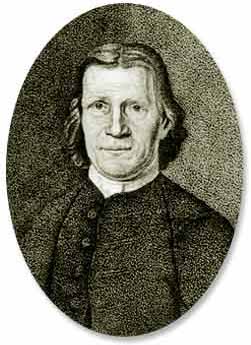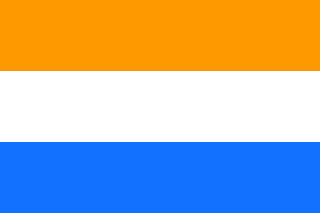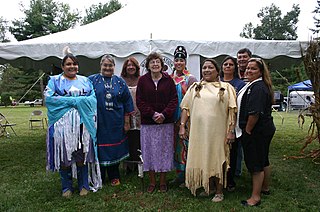
The Mohicans are an Eastern Algonquian Native American tribe that historically spoke an Algonquian language. As part of the Eastern Algonquian family of tribes, they are related to the neighboring Lenape, whose indigenous territory was to the south as far as the Atlantic coast. The Mohican lived in the upper tidal Hudson River Valley, including the confluence of the Mohawk River and into western New England centered on the upper Housatonic River watershed. After 1680, due to conflicts with the powerful Mohawk to the west during the Beaver Wars, many were driven southeastward across the present-day Massachusetts western border and the Taconic Mountains to Berkshire County around Stockbridge, Massachusetts.

The Lenape, also called the Lenni Lenape and Delaware people, are an Indigenous people of the Northeastern Woodlands, who live in the United States and Canada.

Lenapehoking is widely translated as 'homelands of the Lenape', which in the 16th and 17th centuries, ranged along the Eastern seaboard from western Connecticut to Delaware, and encompassed the territory adjacent to the Delaware and lower Hudson river valleys, and the territory between them.

Moravian 47 is an Indian reserve located in Chatham-Kent, Ontario, with an area of 13 square kilometres (5.0 sq mi). It is occupied by the Delaware Nation at Moraviantown First Nation, a part of the Christian Munsee branch of the Lenape, and is commonly known as Moravian of the Thames reserve. The resident registered population is 457, with another 587 band members living off the reserve.
John Henry Kilbuck — sometimes spelled Killbuck (Lenape)— and his wife, Edith Kilbuck, were Moravian missionaries in southwestern Alaska in the late 19th and early 20th centuries. John H. Kilbuck was the first Lenape to be ordained as a Moravian minister. They served the Yup'ik, used their language in the Moravian Church in their area, and supported development of a writing system for Yup'ik.

Daniel Garrison Brinton was an American surgeon, historian, archaeologist and ethnologist.

The Delaware languages, also known as the Lenape languages, are Munsee and Unami, two closely related languages of the Eastern Algonquian subgroup of the Algonquian language family. Munsee and Unami were spoken aboriginally by the Lenape people in the vicinity of the modern New York City area in the United States, including western Long Island, Manhattan Island, Staten Island, as well as adjacent areas on the mainland: southeastern New York State, eastern Pennsylvania, New Jersey, Connecticut, Maryland, and Delaware.

Gitche Manitou means "Great Spirit" in several Algonquian languages. Christian missionaries have translated God as Gitche Manitou in scriptures and prayers in the Algonquian languages.

David Zeisberger was a Moravian clergyman and missionary among the Native American tribes who resided in the Thirteen Colonies. He established communities of Munsee (Lenape) converts to Christianity in the valley of the Muskingum River in Ohio; and for a time, near modern-day Amherstburg, Ontario.

Unami was an Algonquian language spoken by the Lenape people in the late 17th century and the early 18th century, in the southern two-thirds of present-day New Jersey, southeastern Pennsylvania, and the northern two-thirds of Delaware. The Lenape later migrated, largely settling in Ontario, Canada and Oklahoma.

Munsee is an endangered language of the Eastern Algonquian subgroup of the Algonquian language family, itself a branch of the Algic language family. Munsee is one of two Delaware languages. It is very closely related to the Unami Delaware, but the two are sufficiently different that they are considered separate languages. Munsee was spoken aboriginally by Lenape in the vicinity of the modern New York City area in the United States, including western Long Island, Manhattan Island, Staten Island, as well as adjacent areas on the mainland: southeastern New York State, the northern third of New Jersey, and northeastern Pennsylvania.

The Christian Munsee are a group of Lenape, an Indigenous people in the United States, that primarily speak Munsee and have converted to Christianity, following the teachings of Moravian missionaries. The Christian Munsee are also known as the Moravian Munsee or the Moravian Indians, the Moravian Christian Indians or, in context, simply the Christian Indians. As the Moravian Church transferred some of their missions to other Christian denominations, such as the Methodists, Christian Munsee today belong to the Moravian Church, Methodist Church, United Church of Canada, among other Christian denominations.

The Wappinger were an Eastern Algonquian Munsee-speaking Native American people from what is now southern New York and western Connecticut.
Mohican is a language of the Eastern Algonquian subgroup of the Algonquian language family, itself a member of the Algic language family. It was spoken in the territory of present-day eastern New York state and Vermont by the Mohican people but is believed to have been extinct since the 1930s. However, since the late 2010s, the language is being revived, with adults learning the language, and children being raised having Mohican as their first language.

New Netherlanders were residents of New Netherland, the seventeenth-century colonial outpost of the Republic of the Seven United Netherlands on the northeastern coast of North America, centered on the Hudson River and New York Bay, and in the Delaware Valley.

The Munsee are a subtribe and one of the three divisions of the Lenape. Historically, they lived along the upper portion of the Delaware River, the Minisink, and the adjacent country in New York, New Jersey, and Pennsylvania. They were prominent in the early history of New York and New Jersey, being among the first Indigenous peoples of that region to encounter European colonizers.
The Taensa language was spoken by the Taensa people originally of northeastern Louisiana, and later with historical importance in Alabama. Though poorly documented, it was probably a dialect of the Natchez language. It was also the subject of controversy beginning in 1880–1882, when a French student published a grammar and sample texts of a language that he claimed to be Taensa, though it bore no resemblance to Natchez — these publications are generally considered to be a hoax and the language it described to be invented.










